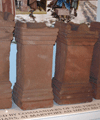Roman Maryport excavation starts on site

Archaeologists from Newcastle University have begun excavating today (31 May) at an internationally important Roman site in Maryport, Cumbria.
Led by Professor Ian Haynes, the excavation team will work through to 20 July, directed on site by archaeologist Tony Wilmott.
“The Maryport altars have been at the centre of international debate about the nature of religion in the Roman army for decades now," said Professor Haynes. “However, we still know very little about the context in which they were originally deposited.
"A geophysical survey conducted in 2010 by Alan Biggins from TimeScape Surveys, in partnership with Southampton University, has given us a better understanding of the site but excavation is the only way to advance the debate. This project represents a marvellous opportunity for us to take that debate forward.”
Maryport was part of the Roman frontier coastal defences extending from Hadrian’s Wall, and is now part of the 150 mile Hadrian’s Wall World Heritage Site.
The excavation will focus on the area where 17 Roman altars were found by Humphrey Senhouse at Camp Farm in 1870. This site contains the remains of a Roman fort and a large civilian settlement within the farm's pastures.
The altar stones are currently displayed in Senhouse Roman Museum next to the site and are the largest group of Roman military altar stones and inscriptions from any site in Britain. They form a series of dedications to the Roman god Jupiter, made every year by the commanders at the fort over 17 years, providing information about their careers across the empire.
Professor David Breeze of the Senhouse Museum Trust said: “The excavation is a valuable opportunity to learn more about this internationally important collection of Roman altars and provide more information for visitors to the museum.”
Any new discoveries, together with the present displays in the Senhouse Roman Museum, will go into the new heritage development planned for Camp Farm - Roman Maryport - which is owned by Hadrian’s Wall Heritage.
Senhouse Museum Trust, which is working in partnership with Hadrian's Wall Heritage on the development of Roman Maryport, has commissioned the excavation and provided funding of £50,000 towards the total cost of the fieldwork.
Linda Tuttiett, chief executive of Hadrian’s Wall Heritage said they hoped the new attraction would open in 2014. “This excavation is an important step towards the establishment of a long-term programme of archaeological research, a key element in the development of Roman Maryport," she said. "It will be a world class heritage destination for domestic and international visitors."
An appeal for excavation volunteers organised by Senhouse Roman Museum has resulted in around 30 people from the local community joining the team to work alongside the archaeologists.
Weekly site activity bulletins from Tony Wilmott will be posted on the University's website, Hadrian’s Wall Country website and the Senhouse Roman Museum website.
The last week of the excavation – Saturday 16 July to Friday 20 July - will coincide with Senhouse Roman Museum’s annual six week Roman Festival and the Festival of British Archaeology (a Council for British Archaeology initiative).
Provided by Newcastle University















